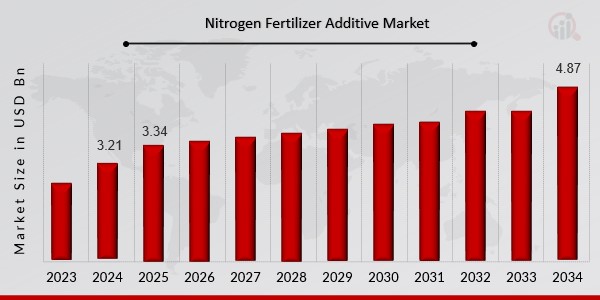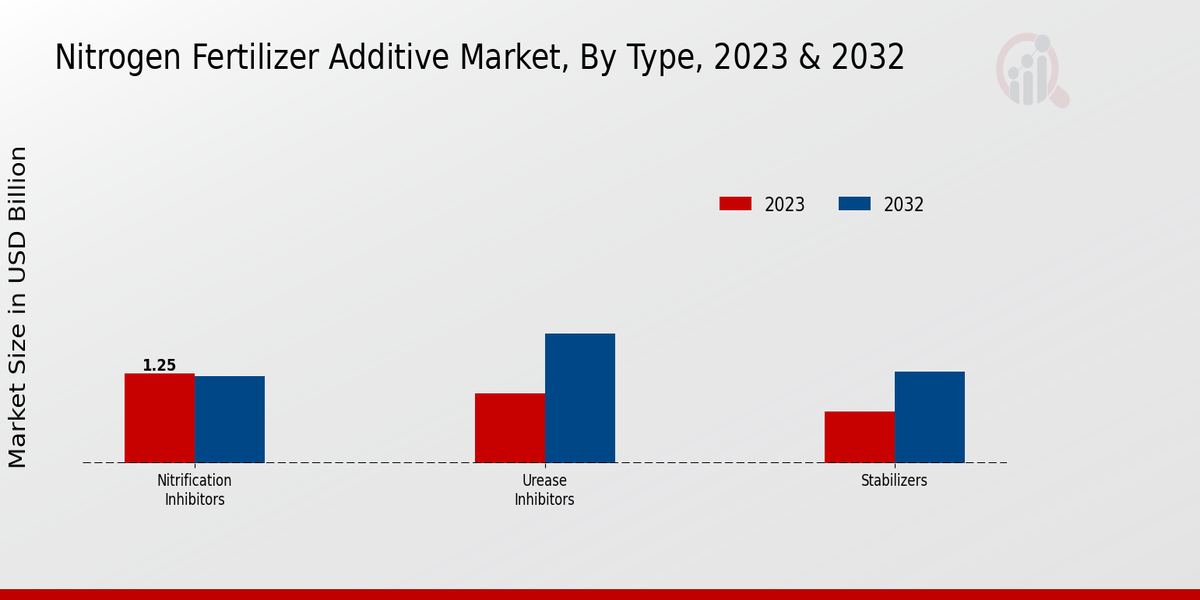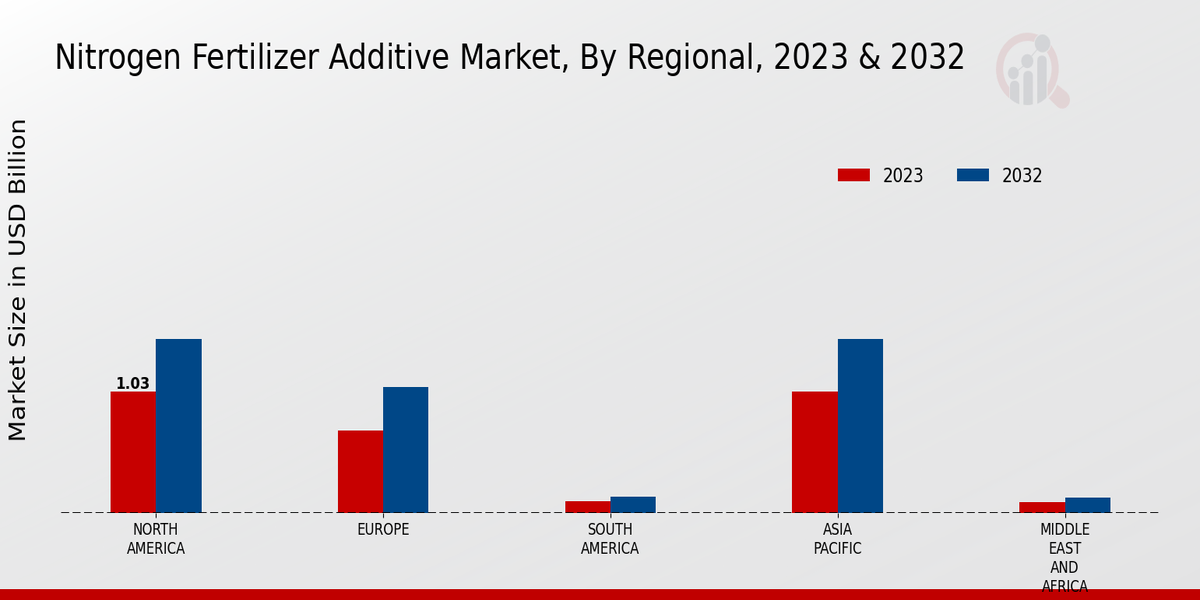Global Nitrogen Fertilizer Additive Market Overview
The Nitrogen Fertilizer Additive Market Size was estimated at 3.21 (USD Billion) in 2024. The Nitrogen Fertilizer Additive Industry is expected to grow from 3.34 (USD Billion) in 2025 to 4.87 (USD Billion) by 2034. The Nitrogen Fertilizer Additive Market CAGR (growth rate) is expected to be around 4.30% during the forecast period (2025 - 2034).
Key Nitrogen Fertilizer Additive Market Trends Highlighted
Factors that favor the growth of the market are the rising demand for high-yield crops, more efficient methods of farming, and the policies aimed at the promotion of Green Agriculture. Emerging markets with burgeoning agricultural industries offer opportunities, as does the advent of new-type materials with improved efficacy when used with fertilizers.
Current developments indicate a trend toward Precision Farming, a method of farming that encourages more environmental awareness by enabling selective fertilizer bracketing. A follow-up on this trend is the gradual proliferation of the use of controlled-release fertilizers that eliminate the possibility of underfeeding or overfeeding crops by providing nutrients over a long-time specific formulation.
The market is also experiencing bacterial-related developments where new microorganisms are provided that enable plants to assimilate atmospheric nitrogen in the form of compounds. This will help reduce the use of synthetic N fertilizers hence encouraging better farming practices.

Source: Primary Research, Secondary Research, MRFR Database and Analyst Review
Nitrogen Fertilizer Additive Market Drivers
Increasing Demand for High-Yield Crops
The rising global population and the consequent increase in food demand have led to a surge in the cultivation of high-yield crops. Nitrogen fertilizer additives play a crucial role in enhancing crop yields by providing essential nutrients to plants, thereby promoting their growth and development. The growing adoption of intensive farming practices, particularly in developing countries, to meet the escalating food requirements is expected to drive the demand for nitrogen fertilizer additives in the coming years.These additives help farmers optimize crop yields, reduce production costs, and enhance their overall profitability, making them an indispensable component of modern agricultural practices within the Nitrogen Fertilizer Additive Market Industry.
Government Initiatives and Regulations
Sustainable agricultural practices and environmental pollution have become concrete concerns worldwide. Governments across the globe are launching different initiatives and regulations to further the cause and to make sure industrial, as well as agricultural, activities do not result in environmental pollution. The new measures especially favor the demand for nitrogen fertilizer additives, as they are instrumental in developing efficient nutrient use while reducing nitrogen losses.The government’s need to reduce nitrogen runoff and groundwater contamination is expected to herald the adoption of nitrogen fertilizer additives. On the other hand, the subsidies from the governments and the push for the use of sustainable farming are expected to further supplement the NFA Market Industry.
Technological Advancements and Innovation
Continuous advancements in technology are leading to the development of innovative nitrogen fertilizer additives with improved efficiency and application methods. Research and development efforts are focused on developing controlled-release fertilizers, nitrification inhibitors, and urease inhibitors that can optimize nutrient availability to plants and reduce environmental impact. These technological innovations are expected to enhance the value proposition of nitrogen fertilizer additives, driving their adoption and contributing to the growth of the Nitrogen Fertilizer Additive Market Industry.
Nitrogen Fertilizer Additive Market Segment Insights
Nitrogen Fertilizer Additive Market Type Insights
The Nitrogen Fertilizer Additive Market segmentation by type includes Nitrification Inhibitors, Urease Inhibitors, and Stabilizers. The Nitrification Inhibitors segment held the largest market share in 2023 and is projected to continue its dominance during the forecast period. The growth of this segment can be attributed to the increasing demand for nitrification inhibitors to reduce nitrogen losses and improve nitrogen use efficiency in agricultural practices. The Urease Inhibitors segment is expected to witness significant growth over the forecast period due to the rising awareness about the environmental benefits of reducing ammonia volatilization and improving nitrogen utilization in crops.The Stabilizers segment is projected to grow at a steady pace during the forecast period, owing to the crescente need for improving the stability and effectiveness of nitrogen fertilizers in various soil conditions. The Nitrogen Fertilizer Additive Market revenue for the Nitrification Inhibitors segment is projected to reach USD 1.25 billion by 2032, growing at a CAGR of 4.5%. The Urease Inhibitors segment is expected to reach USD 0.98 billion by 2032, growing at a CAGR of 4.8%. The Stabilizers segment is projected to reach USD 0.72 billion by 2032, growing at a CAGR of 4.0%.These segments are expected to drive the growth of the Nitrogen Fertilizer Additive Market in the coming years, owing to the increasing demand for sustainable and efficient nitrogen management practices in agriculture.

Source: Primary Research, Secondary Research, MRFR Database and Analyst Review
Nitrogen Fertilizer Additive Market Application Insights
The Nitrogen Fertilizer Additive Market is segmented based on application into corn, wheat, rice, and other crops. The corn segment is projected to account for the largest share of the market in 2023, owing to the increasing demand for corn as a feedstock for biofuels and the rising consumption of corn in animal feed. The wheat segment is expected to witness significant growth over the forecast period due to the rising demand for wheat for food and feed purposes. The rice segment is anticipated to grow steadily due to the increasing demand for rice as a staple food in many Asian countries.Other crops, such as soybeans and barley, are also expected to contribute to the growth of the market. In 2023, the Nitrogen Fertilizer Additive Market revenue was valued at 2.95 USD Billion. The market growth is driven by the increasing demand for nitrogen fertilizers to enhance crop yield and improve soil fertility. Government initiatives to promote sustainable agriculture practices and reduce environmental impact are also contributing to the market growth.
Nitrogen Fertilizer Additive Market Form Insights
The Nitrogen Fertilizer Additive Market is segmented by form into solid, liquid, and granular. In 2023, the solid segment held the largest market share, accounting for over 60% of the global market. The high demand for solid nitrogen fertilizer additives is due to their ease of handling and storage, as well as their high nutrient content. The liquid segment is expected to grow at a CAGR of 4.5% during the forecast period, owing to its ease of application and better nutrient uptake by crops. The granular segment is also expected to grow at a steady pace due to its slow-release properties and ability to improve soil fertility.Overall, the Nitrogen Fertilizer Additive Market is expected to witness significant growth over the coming years, driven by the increasing demand for fertilizers to meet the growing food demand and the adoption of sustainable farming practices.
Nitrogen Fertilizer Additive Market Sales Channel Insights
The Nitrogen Fertilizer Additive Market segmentation by Sales Channel showcases distinct distribution channels that play a crucial role in reaching end-users. Direct Sales involves manufacturers directly supplying products to customers, offering personalized service and control over distribution. In 2023, this channel held a significant market share of around 60%, owing to strong relationships with large-scale farmers and the ability to provide tailored solutions. Distribution Channels, on the other hand, encompass a network of intermediaries, including distributors, wholesalers, and retailers.This channel is expected to grow at a CAGR of 4.5% during 2024-2032, driven by increased accessibility and wider market reach. Strategic partnerships between manufacturers and distributors are key to optimizing product availability and ensuring efficient distribution, contributing to the overall growth of the Nitrogen Fertilizer Additive Market.
Nitrogen Fertilizer Additive Market Regional Insights
The Nitrogen Fertilizer Additive Market is expected to reach USD 4.3 billion by 2032, exhibiting a CAGR of 4.26% during the forecast period. Regionally, North America accounted for the largest revenue share in 2023. The region's well-established agricultural sector and high adoption of advanced farming practices contribute to its dominance. Europe held the second-largest share due to its stringent regulations on crop production and focus on sustainable agriculture. The APAC region is anticipated to witness substantial growth, driven by increasing demand for high-yield crops and government initiatives to promote agricultural productivity.South America and MEA are expected to contribute modest shares to the overall market, but they present growth opportunities due to expanding arable land and increasing investments in the agricultural sector.

Source: Primary Research, Secondary Research, MRFR Database and Analyst Review
Nitrogen Fertilizer Additive Market Key Players And Competitive Insights
Major players in the Nitrogen Fertilizer Additive Market industry are focusing on expanding their product portfolio by introducing new and innovative products. For instance, in March 2023, Yara International ASA launched a new nitrogen fertilizer additive called YaraVita OPTI-NPK, which is designed to improve nitrogen, phosphorus, and potassium uptake in plants. Leading Nitrogen Fertilizer Additive Market players are also investing in research and development to develop new technologies that can improve the efficiency of nitrogen fertilizers. For example, in April 2023, BASF SE announced that it had developed a new nitrogen fertilizer additive called Limus, which is designed to reduce nitrogen losses by up to 30%. The Nitrogen Fertilizer Additive Market is expected to witness significant growth in the coming years, owing to the increasing demand for nitrogen fertilizers from the agriculture industry.Yara International ASA is a leading Norwegian company that produces and distributes nitrogen fertilizers. The company has a global presence and operates in over 60 countries. Yara International ASA offers a wide range of nitrogen fertilizer additives, including YaraVita OPTI-NPK, YaraVita OPTI-S, and YaraVita OPTI-Zn. The company's nitrogen fertilizer additives are designed to improve the efficiency of nitrogen fertilizers and help farmers achieve higher yields.BASF SE is a German multinational chemical company that produces and sells a wide range of products, including nitrogen fertilizers and nitrogen fertilizer additives. The company's nitrogen fertilizer additives are marketed under the Limus brand name. Limus is a nitrogen stabilizer that helps to reduce nitrogen losses by up to 30%. BASF SE is a major player in the Nitrogen Fertilizer Additive Market and is expected to continue to grow its market share in the coming years.
Key Companies in the Nitrogen Fertilizer Additive Market Include
- Fertilizer Corporation of India Limited
- Hindustan Fertilizer Corporation Limited
- Archer Daniels Midland Company
- PotashCorpSaskatchewan Inc.
- CF Industries Holdings, Inc.
Nitrogen Fertilizer Additive Market Industry Developments
Increasing demand for nitrogen fertilizers to enhance crop yield and quality, along with government initiatives to promote sustainable agriculture practices, are driving market growth. Rising environmental concerns and the need to reduce nitrogen losses from fertilizers are also contributing to the demand for nitrogen fertilizer additives. Key industry participants include BASF, Yara, and Koch Agronomic Services. Recent developments include the launch of new products, such as BASF's Limus, a nitrification inhibitor, and Yara's N-Protect, a urease inhibitor.
Nitrogen Fertilizer Additive Market Segmentation Insights
Nitrogen Fertilizer Additive Market Type Outlook
Nitrogen Fertilizer Additive Market Application Outlook
Nitrogen Fertilizer Additive Market Form Outlook
Nitrogen Fertilizer Additive Market Sales Channel Outlook
Nitrogen Fertilizer Additive Market Regional Outlook
| Report Attribute/Metric |
Details |
| Market Size 2024 |
3.21 (USD Billion) |
| Market Size 2025 |
3.34 (USD Billion) |
| Market Size 2034 |
4.87 (USD Billion) |
| Compound Annual Growth Rate (CAGR) |
4.30% (2025 - 2034) |
| Report Coverage |
Revenue Forecast, Competitive Landscape, Growth Factors, and Trends |
| Base Year |
2024 |
| Market Forecast Period |
2025 - 2034 |
| Historical Data |
2020 - 2024 |
| Market Forecast Units |
USD Billion |
| Key Companies Profiled |
Fertilizer Corporation of India Limited, BASF SE, Koch Fertilizer, LLC, Sinochem Group, The Mosaic Company, Hindustan Fertilizer Corporation Limited, Evonik Industries AG, Archer Daniels Midland Company, PotashCorpSaskatchewan Inc., Borealis AG, OCP Group, EuroChem Group AG, ICL Group Ltd., Yara International ASA, CF Industries Holdings, Inc. |
| Segments Covered |
Type, Application, Form, Sales Channel, Regional |
| Key Market Opportunities |
Rising demand for nitrogen fertilizers Growing adoption of precision farming Increasing focus on sustainable agriculture Development of new and improved nitrogen fertilizers Government initiatives to promote nitrogen fertilizer additives. |
| Key Market Dynamics |
Rising crop yields Growing demand for sustainable agriculture Technological advancements in fertilizer production Increasing use of precision farming techniques Government support for agriculture. |
| Countries Covered |
North America, Europe, APAC, South America, MEA |
Frequently Asked Questions (FAQ) :
The Nitrogen Fertilizer Additive Market is expected to reach a valuation of 3.34 billion USD in 2025.
The Nitrogen Fertilizer Additive Market is projected to grow at a CAGR of 4.30% from 2025 to 2034.
North American region is expected to be the largest market for nitrogen fertilizer additives, followed by North America and Europe.
Nitrogen fertilizer additives are primarily used to enhance the efficiency of nitrogen fertilizers, reduce leaching and volatilization, and improve crop yield and quality.
Key competitors in the Nitrogen Fertilizer Additive Market include BASF, Yara, Koch Industries, and Sumitomo Chemical.
Challenges faced by the Nitrogen Fertilizer Additive Market include regulatory restrictions, environmental concerns, and the availability of low-cost substitutes.
Opportunities for growth in the Nitrogen Fertilizer Additive Market include the increasing demand for sustainable agricultural practices, the development of new technologies, and the expansion into emerging markets.
Key trends shaping the Nitrogen Fertilizer Additive Market include the adoption of precision farming techniques, the integration of digital technologies, and the growing focus on environmental sustainability.
Factors driving the demand for Nitrogen fertilizer additives include the need to improve fertilizer efficiency, reduce environmental impact, and increase crop yields.
Restraints on the growth of the Nitrogen Fertilizer Additive Market include regulatory restrictions, high production costs, and the availability of low-cost substitutes.
















